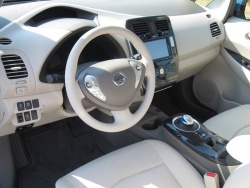 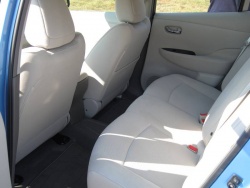 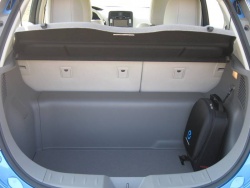 2012 Nissan Leaf. Click image to enlarge |
As mentioned above, the Nissan Leaf is a fully realized car. As far as packaging is concerned, there is no compromise that occupants must make due to its motive power; no battery that intrudes into the passenger area; no rear seats that don’t fold; no legroom that is lost. An unexpected benefit — and we’d love to do a representative comparison test — is that it is probably quieter and smoother than any luxury car you can buy, at any price. The motor makes virtually no sound at all, and because of this, Nissan engineers found that noise from other vehicle components (windshield wipers, antenna, tire noise, suspension) was made more obvious by the lack of background sound to mask it. Consequently, these components and many others have been specially designed for the Leaf, resulting in an even quieter vehicle.
On the road, the Leaf is comfortable, spacious (for a compact car) and smooth. There is, however, no pretence at all to be sporty. There is body roll in corners and the suspension is quite soft. Acceleration is quick off the line, but there is less urge as speed builds (although Leaf is fast, with a top speed of 140 km/h and no trouble at all with, and beyond, typical highway flow).
The drive selector (formerly what you would call a “gearshift”) is a simple control on the centre console from which you choose Drive, Reverse, Park. The driver can also select an “Eco” mode that activates more aggressive regenerative braking and produces very leisurely acceleration. The Leaf does not “get up and go” in this mode, but it conserves your charge.
Despite the truly laudable effort required to bring such a fully integrated, state-of-the-art, progressive vehicle to market, the Leaf (and vehicles like it) has issues. First, the limited range restricts this vehicle to local travel only and requires continuous recharging (at least daily; maybe multiple times daily) to maintain its usefulness. For many consumers, continuously charging the vehicle will range from inconvenient to impossible.
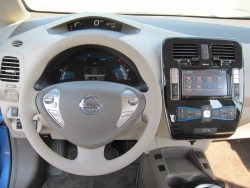 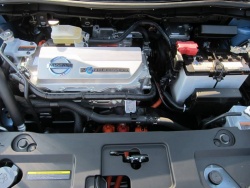 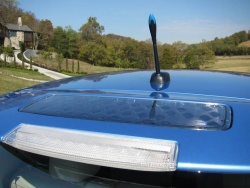 2012 Nissan Leaf. Click image to enlarge |
Second, this is a compact car, and it will be comparatively expensive. Better value and usability will be found in conventionally powered vehicles — even when the Leaf’s low operating cost is factored — including diesels and hybrids.
Consequently, a special buyer is required for the Nissan Leaf (at least initially); the “early adopter,” the “tech savvy,” the “eco-minded.” And from a practical point of view, the person with a garage where the Leaf can be charged (some municipalities may have special requirements or prohibitions regarding the installation of 240V outlets in household garages or driveways, which would make Leaf ownership problematic.).
Nissan Leafs (Leaves?) will not be available until Fall, 2011, as 2012 models. Should you be interested in owning one, Nissan has developed a completely new way of purchasing experience (Leaf Customer Journey) that starts with a visit online, and progresses to a home visit by a Nissan representative to pre-screen buyers. In these early days, Nissan believes, it’s crucial that buyers are made fully aware of the limits and benefits of the Leaf, along with the home modifications that may be required to facilitate charging.
At this point, prospective buyers can go to the Leaf microsite at Nissan.ca/leaf and sign up as a “hand raiser” (a person interested in purchasing the car when it becomes available). Subsequently a reservation can be made (with a fee) in early Spring, 2011. An order can be placed in Summer, 2011, followed by purchase and delivery in late 2011.
Pricing is not yet available for the 2012 Nissan Leaf, but US$32,000 has been announced for the U.S. However, it may be higher in Canada. Ontario buyers will be eligible for an $8,500 rebate for purchasing a zero emission vehicle, and Quebec buyers can take advantage of an $8,000 tax credit. Other provinces may offer incentives in the future.
Production of the Leaf is getting underway, with 20,000 vehicles expected to be available for the global market next year. For 2013, the number rises to 300,000. Whether this dramatically overestimates, underestimates or accurately estimates demand has yet to be determined. One thing is for sure: the Nissan Leaf is a real deal. It’s a truly impressive accomplishment.









